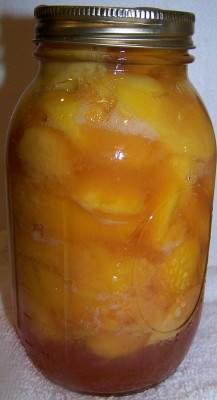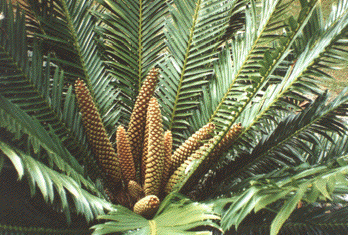
Preview
Material for Exam 2 - Spring 2006
Print
the PDF version (no pictures, better printing)
Cycads are the oldest living seed plants. Most look like a small palm but instead of flowers they develop cones. Cycads produce many secondary compounds, some of which are poisonous. One of these compounds is a neurotoxin called BMAA (beta-methyl-L-amino alanine). When tested on isolated animal neurons, BMAA stimulates glutamate (a neurotransmitter) receptors. In primates, BMAA causes immediate convulsions. Humans and bats use the cycad seeds as a food. Bats that consume the seeds are not poisoned by the BMAA. Humans are sensitive to BMAA but they prepare the seeds for eating in a way that removes the BMAA. Experiments in plants indicate that BMAA have a role in plant development in addition to its role in defense against herbivores.
You have two plants with photosynthetic red leaves growing in a window that receives direct sunlight. You decide to give one of the plants to a friend who places the plant under artificial lights in her bedroom. One day you notice that the plant is not growing as well as your plant.
On another visit to your friend’s apartment you noticed that the plant was wilted.
Your friend also had a hamster in a cage that was right next to the plant and occasionally nibbled on the leaves. One day your friend called you up and was very upset because her hamster had died in her hands that morning. She knew you were in Biology 1114 so she told you that the hamster was convulsing before it expired.
 source
source source
sourceYou were hired to work in the plant physiology section of a large agrochemical company. The chemistry section has created a new compound (called compound D) that has been found to kill dandelions. Now it is your job to determine what the mode of action is for this compound. You set up an experiment and obtain the following results:
 source
sourceTreatment |
Oxygen produced in the light (mmole O2/hour) |
Carbon dioxide consumed in the light (mmole CO2/hour) |
Carbon dioxide produced in the dark (mmole CO2/hour) |
No compound |
100 |
100 |
100 |
Compound D |
100 |
<5 |
100 |
 source
sourceWeb-building in spiders is genetically-based, i.e., members of a particular species build a particular type of web in specific way that is influenced little, if at all, by experience or learning. Dr. Todd Blackledge and Dr. Rosemary Gillespie studied spiders on the Hawaiian Islands that belonged to the genus Tetragnatha. Different spiders are found in different habitats on the different islands and the spiders on the different islands build different types of webs.
 source
source source
sourceOne afternoon, while rummaging through your grandmother’s root cellar, you and a friend find a jar of canned peaches. Your friend is an absolute peach fiend, so he opens the jar and eats half of the contents in just a few bites. He offered you the rest, but you declined. You close up the jar and put it in your grandmother’s refrigerator as you go back up stairs. The next morning, your friend wakes up complaining of nausea and begins to vomit. Within an hour he is suffering from muscle fatigue. The muscle weakness/paralysis worsens quickly and his breathing becomes shallow. You rush him to the hospital, where he is placed on a ventilator to maintain his breathing.
 source
source